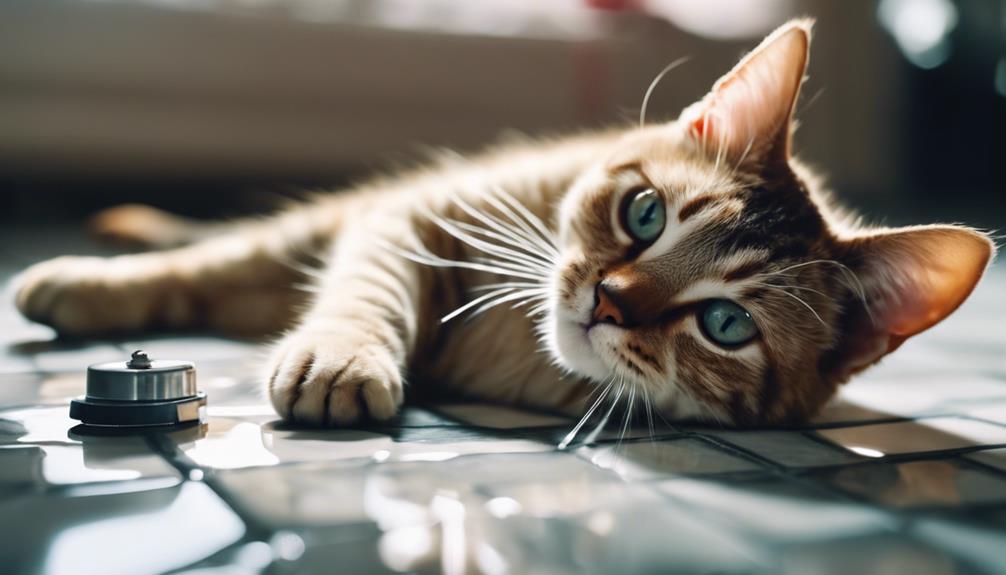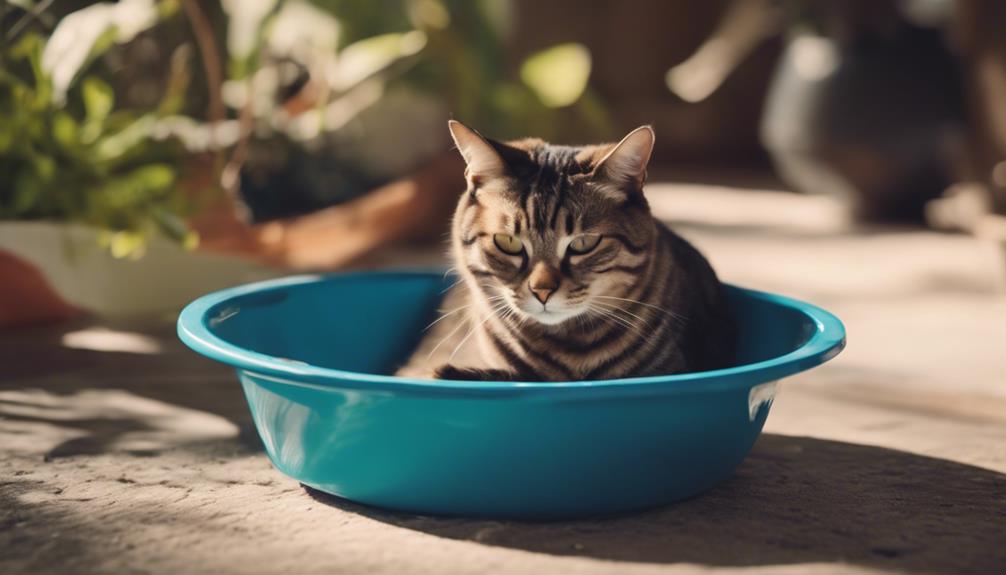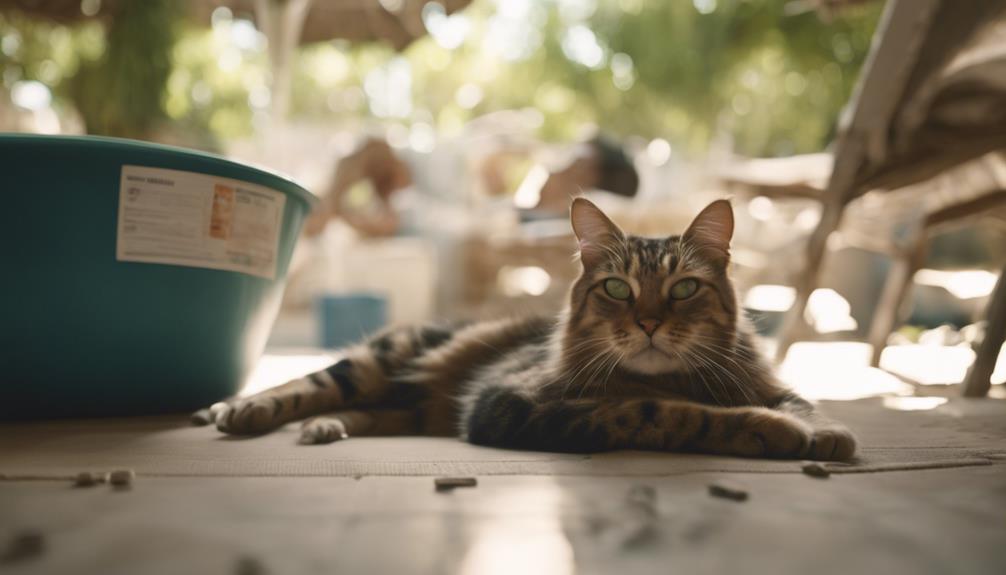With the rising temperatures and potential risks that heatstroke poses to our feline companions, it becomes crucial for cat owners to be well-informed and proactive in safeguarding their pets.
While heatstroke in cats is indeed rare, the gravity of the situation cannot be underestimated. By delving into the preventive methods outlined in this discussion, cat owners can equip themselves with the necessary tools to protect their beloved pets from the perils of heatstroke.
Stay tuned to uncover the essential strategies and insights that can make a significant difference in ensuring the safety and well-being of your feline friends.
Key Takeaways
- Cats can suffer heatstroke, especially in enclosed spaces like dryers.
- Breeds like brachycephalic cats are more prone to heat exhaustion.
- Watch for signs like high body temperature, collapse, and abnormal behaviors.
- Provide cool, shady areas and monitor your cat's health in hot weather.
Recognizing Heatstroke Risk Factors in Cats
When considering the risk factors for heatstroke in cats, it is crucial to be aware that certain breeds, such as brachycephalic cats, are particularly susceptible to heat exhaustion. Brachycephalic cats, with their flat faces and shortened airways, struggle more to regulate their body temperature, making them more vulnerable to overheating.
Additionally, cats with long coats, physical impairments, or obesity are at higher risk of heat-related issues. It's essential to understand these predisposing factors and take preventive measures to ensure the well-being of our feline companions.
Identifying Signs and Symptoms of Heatstroke
To effectively recognize heatstroke in cats, it is crucial to be vigilant for specific signs and symptoms indicative of this life-threatening condition. Heatstroke in cats can manifest through various alarming indicators. Here are some common signs and symptoms to watch out for:
| Signs and Symptoms | Description | Action Needed |
|---|---|---|
| Body temperature >105°F | An elevated body temperature beyond normal levels | Seek veterinary care |
| Collapse | Sudden falling or inability to stand | Keep cat cool |
| High heart rate | Rapid heartbeat above usual resting rate | Monitor closely |
Administering First Aid for Cat Heatstroke

Administering immediate first aid is crucial in effectively managing heatstroke in cats. If you suspect your cat is suffering from heatstroke, quickly move them to a cool, shaded area.
Avoid using ice or ice water for cooling, as this can worsen the condition. Instead, gently wet their fur with cool water and use a fan to help lower their body temperature. Monitor the cat closely and never force them to drink water.
Contact your veterinarian immediately for further guidance. Remember, handling a cat in critical condition requires caution and gentleness. By acting swiftly and appropriately, you can increase the chances of a positive outcome for your furry friend.
Understanding Treatment Protocols for Heatstroke
Understanding the intricacies of treatment protocols for heatstroke in cats is essential for ensuring timely and effective care in emergency situations. When a cat shows signs of heatstroke, immediate action is crucial.
Move the cat to a cool, shaded area, and monitor its temperature closely. Never use ice or ice water for cooling, as this can lead to further complications. Avoid forcing the cat to drink water.
If the cat is unresponsive or excessively panting, seek veterinary assistance promptly. Handling a cat in critical condition requires caution and gentleness.
Implementing Preventive Measures for Cat Heatstroke

Exploring proactive strategies to safeguard cats from heatstroke involves a comprehensive approach encompassing environmental adjustments and attentive observation of feline behaviors.
To effectively prevent heatstroke in cats, consider the following:
- Maintain Adequate Hydration: Ensure your cat has access to fresh water at all times, especially during hot weather.
- Create Cool Areas: Provide shady spots indoors and outdoors where your cat can relax comfortably away from direct sunlight.
- Monitor Behavior: Pay close attention to your cat's behavior for any signs of distress, such as excessive panting or lethargy.
Providing a Safe Environment for Cats
To ensure the well-being of cats and minimize the risk of heatstroke, creating a safe and conducive environment is paramount. Cats should have access to cool, shaded areas where they can retreat from the heat. Ensure proper ventilation in your home to prevent overheating, especially during hot weather. Keep curtains or blinds closed to block out direct sunlight.
Provide fresh water at all times and consider adding ice cubes to keep it cool. Avoid leaving cats in enclosed spaces like cars or rooms without proper airflow. Additionally, be mindful of hot surfaces like asphalt that can burn their paws. By implementing these measures, you can help safeguard your feline companion from the dangers of heatstroke.
Exploring Additional Resources and Information

Further insights into heatstroke prevention and feline well-being can be gained through supplementary resources and informational materials. For cat owners seeking to delve deeper into this topic, the following resources can provide valuable information and guidance:
- The American Society for the Prevention of Cruelty to Animals (ASPCA): Offers detailed articles on heatstroke prevention in cats, including risk factors, signs to watch for, and first aid measures.
- The American Veterinary Medical Association (AVMA): Provides guidelines on creating a safe environment for cats during hot weather, recognizing heatstroke symptoms, and administering proper first aid.
- Local Veterinary Clinics and Animal Shelters: Reach out to these professionals for personalized advice on keeping your feline companions cool and safe in the heat.
Frequently Asked Questions
Can Cats Experience Heatstroke if Left in a Car on a Hot Day?
Yes, cats can experience heatstroke if left in a car on a hot day. The enclosed space of a vehicle can trap heat, rapidly raising a cat's body temperature to dangerous levels. Immediate action is crucial to prevent heat-related emergencies.
Are There Any Specific Age Groups of Cats That Are More Susceptible to Heatstroke?
Certain age groups, like senior or very young cats, may be more susceptible to heatstroke due to reduced thermoregulation abilities. Monitoring older and kitten cats closely during hot weather can help prevent heat-related issues.
How Long Does It Take for a Cat to Show Symptoms of Heatstroke After Being Exposed to High Temperatures?
Symptoms of heatstroke in cats can manifest quickly after exposure to high temperatures, typically within 10-30 minutes. Signs include elevated body temperature, collapse, rapid heart rate, and respiratory distress. Immediate intervention is crucial for a positive outcome.
Can Heatstroke in Cats Lead to Long-Term Health Issues or Complications?
Heatstroke in cats can lead to long-term health issues or complications if not promptly addressed. Severe cases may result in organ damage, neurological problems, or even death. Immediate treatment and prevention are crucial for safeguarding feline well-being.
Are There Any Specific Medications or Supplements That Can Help Prevent Heatstroke in Cats?
There are no specific medications or supplements proven to prevent heatstroke in cats. Focus on preventive measures like providing adequate shade, water, and monitoring your cat's behavior during hot weather to safeguard against heat-related issues.
Conclusion
In conclusion, understanding the risk factors, signs, and symptoms of heatstroke in cats is crucial for their well-being. By promptly recognizing and addressing heatstroke, administering appropriate first aid, and implementing preventive measures, cat owners can safeguard their feline companions from this potentially life-threatening condition.
Creating a safe and conducive environment during hot conditions is essential in mitigating the risk of heatstroke in cats. Stay informed and proactive to protect your beloved feline friends.




